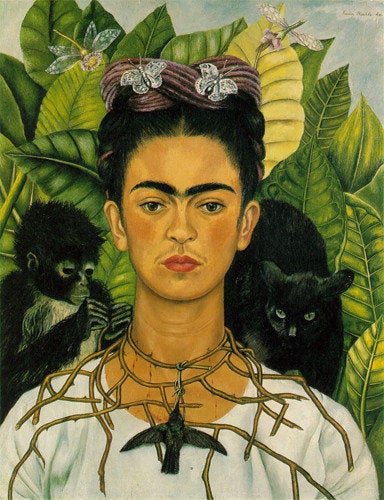
Frida Kahlo's works conveyed complex physical and psychological turmoil, often with astounding anatomical accuracy. Infertility remained a motif throughout her works, with the artist creating haunting visions of fetuses, bloody bedsheets and connected umbilical cords. Though the symbolism of her heartache has been researched by art historians for decades, her unexpected mastery of human anatomy was not investigated until now.
Dr. Fernando Antelo is a surgical pathologist at UCLA. When he looked at Kahlo's painted stories, he did not just see a figurative representation, he saw a medical mystery. From the anatomic precision in the works it looked as if Kahlo had visited a doctor or at least studied medical books in her spare time. Dr. Antelo told MSN: “I see her as a patient wanting to tell me about her symptoms, and at the same time I see her advanced knowledge, her ability to tell me about it as another physician would."

Frida Kahlo and her husband Diego Rivera.
While many historians have dug into the possible sources of Kahlo's pain, this is the first medical research conducted on the subject of her infertility. Antelo diagnosed Kahlo with a rare condition called Asherman's syndrome, which occurs when scar tissue forms within the uterine cavity. The disease likely came from a tragic streetcar accident when the artist was a teenager; a metal handrail penetrated her abdomen, leaving her temporarily paralyzed. "The trauma severely damaged her skeletal framework and internal organs -- including the uterus," Antelo explained: "Her survival defied the grim prognostication by her physicians; however, complications from this physical trauma would emerge in her adulthood." Antelo presented his research on Sunday at the American Association of Anatomists' annual meeting in San Diego.
These medical findings illuminate more concrete realities behind many of Kahlo's darker works, including "Henry Ford Hospital," in which a red baby floats above Kahlo's naked body. In the image, the white sheets she rests on are soaked in blood; there is an umbilical string tied to her pelvis, which is floating near her as she sheds a single tear. This research also brings a new level of understanding to "My Birth," a disturbing depiction of a still birth with a surreal touch. In this painting, the sheets cover her face; only her lower body is visible. Her wide thighs work to expel her own head. Blood is, again, present on the white sheets beneath her. After these findings, it is difficult to look at her artwork without associating it with the accident.
This new medical conclusion provides a sense of closure on Kahlo's life of suffering, since her visual stories helped future generations make a diagnosis that was not possible in her time. We're just sorry that it took so long for this discovery to be made.
Correction: In an earlier version of this article Dr. Antelo's name was misspelled. We regret this error.
